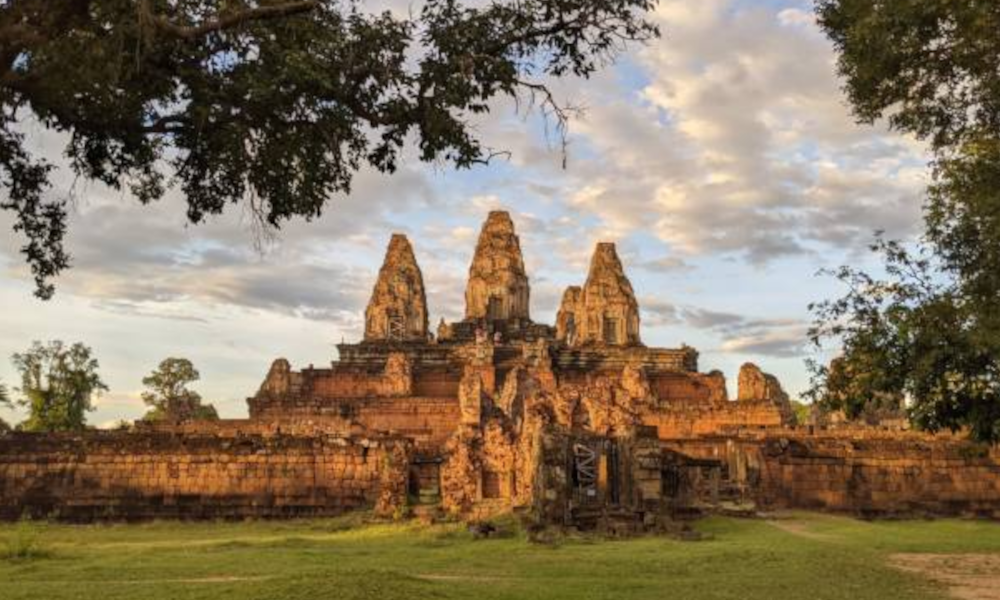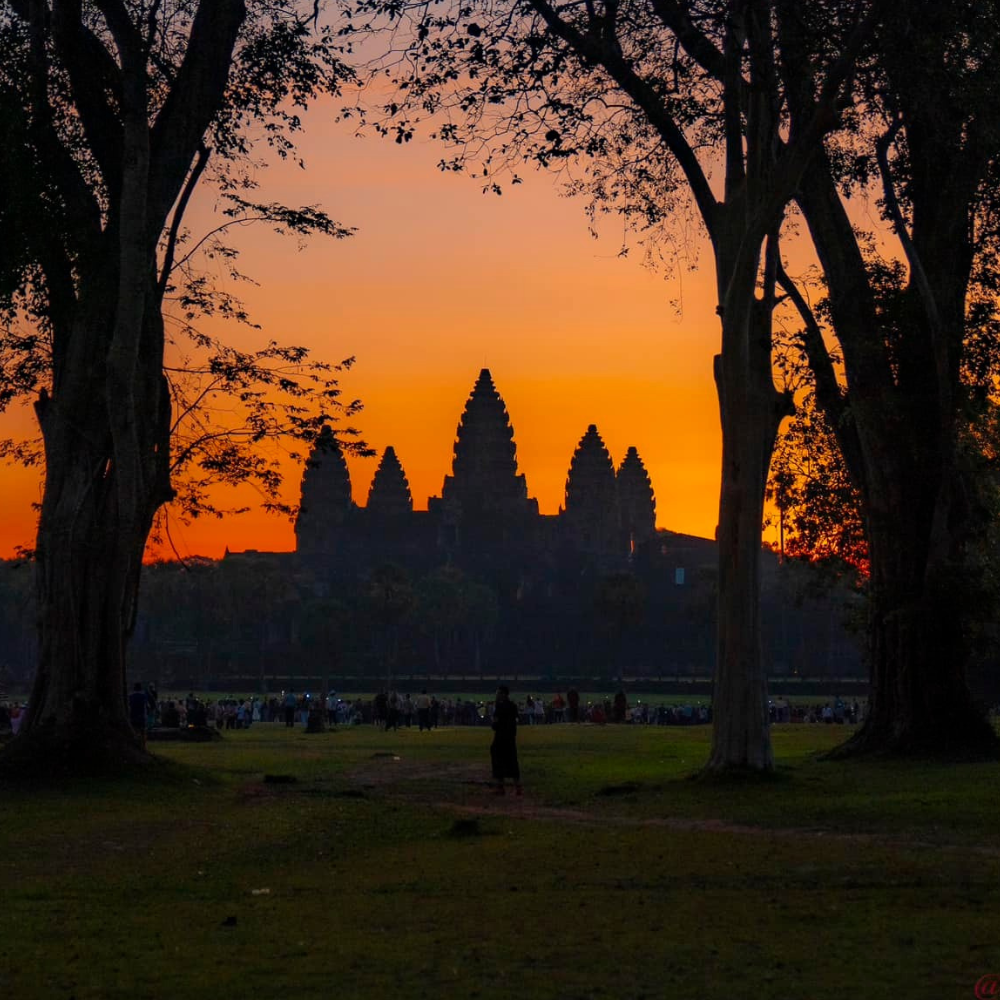Pre Rup Temple

The contemporary name of this grand and fascinating temple mountain, which can be somewhat misleading, translates to ‘turning the body’ and alludes to an ancient cremation ritual. Nevertheless, the temple was constructed shortly after Angkor regained its status as the capital city following a period of political turmoil in the 10th Century. Its inception was not connected to cremation practices. King Rajendravarman II selected this location, situated just south of the southernmost wall of East Baray, for his state temple, which was dedicated to the Hindu deity, Shiva. This state temple marked the establishment of a 1km square city as his capital, although scant remnants of any boundary walls or what would have been impressive laterite causeways extending eastward remain.
An amazing Angkor Wat Sunrise Tour that takes you back in time to see the awesome temples of the Khmer Empire.
Layout and Design
The utilization of grey sandstone, which is less resilient than the stone commonly employed in the construction of temples during that era, has resulted in an accelerated deterioration of the weathered structure. Although the site is gradually succumbing to decay, visitors can still traverse the extensive galleries and libraries—characteristic elements of 10th-century architecture that have not been replicated in temples constructed after the completion of Pre Rup.
Tourists can observe lion statues that stand sentinel, along with intricately carved lintels, doorways, and colonettes, all adorned with decorative lime mortar work. The architect Kavindrari-mathana designed gopuras, or cross-shaped openings, in each wall, each featuring three doorways. Additional structures were erected during the reign of Jayavarman V.
At the heart of the central enclosure lies the famed stone ‘cistern,’ believed to have served as the base for a bronze statue of Nandi, rather than for cremation purposes, which was a misconception that arose in later periods.
The symmetry of the city’s square layout is accentuated by a square-based pyramid at its center, comprising three tiers and reaching a height of 12 meters. The lower tier is encircled by 12 small shrines, while the upper tier is adorned with five towers—one at each corner and one centrally located. A two-tiered platform supports this central tower, which, despite its crumbling state, remains impressive in scale and resilience. Observant visitors may notice false doors, while the only authentic door is located on the eastern side of the tower, flanked by intricately carved deities.
History of Pre Rup
Pre-Rup was constructed as the state temple for King Rajendravarman during the late 10th century, specifically in either 961 or 962 AD. This temple was erected merely nine years after the East Mebon, located approximately 1.3 kilometers to the north.
The precise purpose of the temple remains uncertain; however, the contemporary name “Pre Rup” implies its association with funerary practices. French historian Philippe Stern proposed that Pre Rup was situated at the heart of a new city established by King Rajendravarman, although this assertion lacks definitive confirmation.
The historical importance of Pre-Rup is underscored by its status as the second temple constructed following the relocation of the Khmer capital to Angkor Thom, a move prompted by a period of political upheaval. The capital transitioned from Koh Ker back to Angkor Thom, where it remained until the decline of the Khmer Empire.
Like many other temples in the region, it is believed that Pre Rup was abandoned at some point during the 16th century.
Although it was rediscovered in the late 19th century, Pre Rup remained largely obscured and buried under vegetation until the 1930s, when it was excavated by French explorers Henri Marchal and George Trouve. Today, the temple is preserved in remarkable condition.
Pre Rup has been recognized as a UNESCO World Heritage Site.
Location & How to Get There
Other Temples
-
Ak Yum Temple
-
Tep Pranam Temple
-
Khleangs Temple
-
Spean Thma
-
Prasat Suor Prat
-
Preah Pithu Group
-
Preah Palilay
-
Terrace of the Leper King
-
Terrace of the Elephants
-
Phimeanakas Temple
-
Banteay Prei Temple
-
Banteay Srei Temple
-
Prasat Kravan Temple
-
Ta Keo Temple
-
Chau Say Tevoda Temple
-
Thommanon Temple
-
Pre Rup Temple
-
East Mebon Temple
-
Ta Som Temple
-
Neak Pean Temple
-
Phnom Bakheng
-
Phnom Krom Mountain
-
Preah Khan Temple
-
Roluos Group
-
Banteay Kdei Temple
-
Baphuon Temple
-
Banteay Samre Temples
-
Beng Mealea Temple
-
Ta Prohm Temple
-
Bayon Temple
-
Angkor Thom Temple
-
Angkor Wat Temple
Experiences in Siem Reap
-
Cambodia Visa Requirements: All thing you need to know
-
Cambodia SIM Card: How to buy and price details
-
Money Exchange in Cambodia: What travelers need to know?
-
Useful Contacts For Travelers In Cambodia
-
Tourist Info Center: When Travel in Cambodia
-
Angkor Archeological Park
-
Suggested Siem Reap Itineraries
-
Reasons Against Financial Assistance to Begging Children
-
Pub Street
-
Siem Reap’s Local Markets
Cambodia Guide
-
Preah Vihear Province
-
Tonel Sap
-
Siem Reap Province
-
Cambodia Seasons
-
Mekong River
-
Battambang Province
-
Kampot
-
Sihanouk Ville
-
Phnom Penh: The campital city of Cambodia
-
National Religion of Cambodia - Buddhism
-
The History of Cambodia
-
Introduction to Cambodia
-
Public Holidays in Cambodia
-
Best Time to Visit Cambodia

